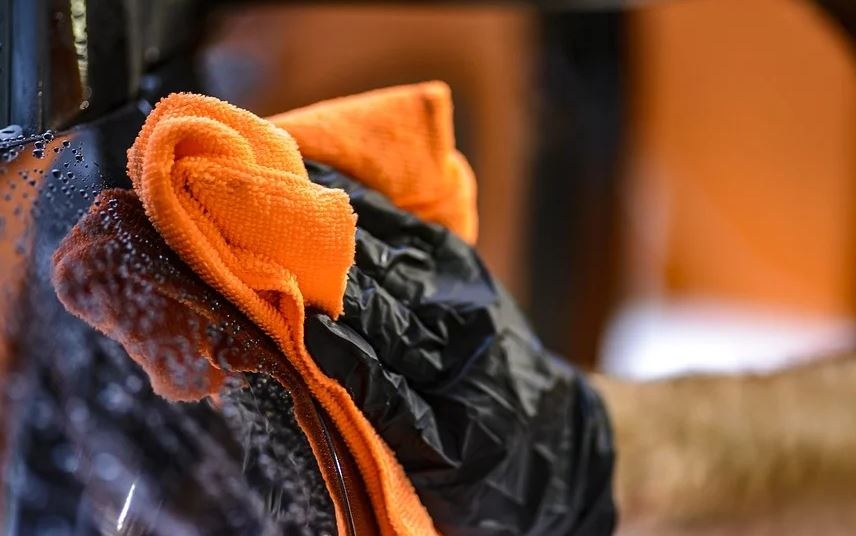Need help? We're here!
(888) 312-8812 Login SignupHow To Sanitize Your Truck: 3 Common Questions Answered
August 31, 2020

Image Source: Pixabay
Cleanliness has always been a crucial part of trucking, especially when spending long hours on the road. For many truckers, this means taking the time to learn how to keep a truck cab clean and properly disinfect their vehicles. While cleaning before a shift is nothing new, sanitation has taken on a greater role in keeping drivers healthy and comfortable. Many trucking companies and even rest stops have started issuing instructions or at least recommendations to ensure the protection of both their employees and their clients.
How Do You Sanitize Your Truck?
Regardless of the size and type, experts recommend wiping all surfaces inside your vehicle at the start of the shift. Hard surfaces that get touched often, including the steering wheel, gear shifter or selector, all switches and controls, touchscreen displays, windows, and the interior and exterior door handles, must be wiped thoroughly with an appropriate cleaning product and disinfectant.
For porous surfaces such as mattresses in your sleeper, you can use a commercial spray-on disinfectant or have it laundered if necessary. It's also recommended for porous surfaces, such as fabric seats and mattresses, to be covered by disposable or reusable plastic covers for easier cleaning and sanitation.
There are several ways to keep a truck clean, such as vacuuming the floor and carpeted surfaces to prevent the spread of dirt and germs. However, this should only be done after the vehicle has been disinfected and with machines that are equipped with HEPA filters. Experts also advise against using compressed air or pressurized water for cleaning, as this may cause splashing or send contaminants airborne.
What Cleaning/Disinfectants Should You Use?
According to the CDC, routine cleaning with soap or detergent and water to remove dirt and organic substances, followed by the use of disinfectants, can effectively reduce the spread of germs and bacteria. Please note that cleaning alone will not kill germs, as detergents will only remove them from surfaces. Disinfectants, on the other hand, kill germs outright and virtually eliminate the risk of infection.
The CDC has published a list of disinfectants approved for use in both residential and commercial settings, ranging from household cleaning products to industrial-grade ones. The most common ones include:
-
Sodium hypochlorite. The active ingredient in laundry bleach is readily available in stores. A mixture of five tablespoons or 1/3 cup of bleach per gallon of water is enough to sanitize hard surfaces. The odor may prove to be too pungent, but there are scented products available to mitigate the smell. Do not mix bleach with ammonia or other types of cleansers, as the resulting vapor is hazardous when inhaled.
-
Hydrogen peroxide. The CDC states that a solution of 3% hydrogen peroxide mixed with water can kill most viruses and bacteria within minutes. They also recommend cleaning the surface with soap or detergent, followed by spraying or wiping down the area with the peroxide solution. Be sure not to use concentrations higher than 3% as it can be dangerous to your health. Certain surfaces, such as granite and fabric, may also result in fading or discoloration when exposed to peroxide.
-
Chlorine dioxide. A standard cleaning agent in the foodservice industry, chlorine dioxide is becoming a popular choice for truckers as well. It's known to have twice the oxidizing power of liquid bleach, making it effective against a wide range of viruses and bacteria. It also generates less odor and comes in a tablet form, making it easier to store and transport. Generally, at least 2mg of liquid chlorine dioxide or one 4mg tablet per liter is enough for disinfection.
-
Alcohol. The World Health Organization (WHO) says that alcohol-based products such as hand sanitizers are just as effective as soap to eradicate germs, provided they have concentrations of at least 60–70%. If you’re a truck driver who likes to stay active on the road—perhaps doing stretches or quick workouts—you’re bound to get your hands dirty. Having alcohol-based wet wipes in the vehicle is a must to keep your hands clean and prevent germs from spreading.
Regardless of what cleaning products or lubricants for peak truck performance, be sure to work in a well-ventilated area and wear protective gloves. Wipes or rags used in cleaning should also be properly disposed of or laundered after use.
Should I Wear Gloves?
The CDC recommends wearing personal protective equipment (PPE), particularly non-sterile disposable gloves, when touching contaminated surfaces or handling cleaning or disinfectant solutions. Eye protection, including goggles or face shields, may be needed if splashing is expected.
In addition to wearing gloves and other types of PPE, it's also essential to remove and dispose of them properly. In fact, medical experts urge caution with using gloves as people tend to absent-mindedly expose their hands to the exterior of the glove after using them, and increase the risk of contamination. Washing your hands is a must after removing your gloves or, if you don't have access to running water, use hand sanitizer to help reduce the risk of spreading germs.
According to the CDC, the following are the proper procedures for removing used gloves:
- Using your gloved hand, pinch the outside of the other glove at the wrist. Make sure not to touch your bare skin while you do so.
- Carefully peel the glove away from your hand until it is inside out.
- With the now-removed glove in your gloved hand, peel off the other glove by inserting your fingers from your free hand inside the glove under your wristband. Take care not to touch the exterior of the glove or rip the material in the process.
- Turn the glove inside out while pulling it away from the body. If done correctly, the first glove should be within the second one.
- Immediately dispose of the gloves in the trash and wash your hands thoroughly.
Not bringing your used gloves inside the vehicle is a great way to keep your truck roadworthy and prevent contamination from spreading to other surfaces you’ve already cleaned. Clean hands and a tidy workspace can go a long way toward keeping both you and your truck in top condition.



